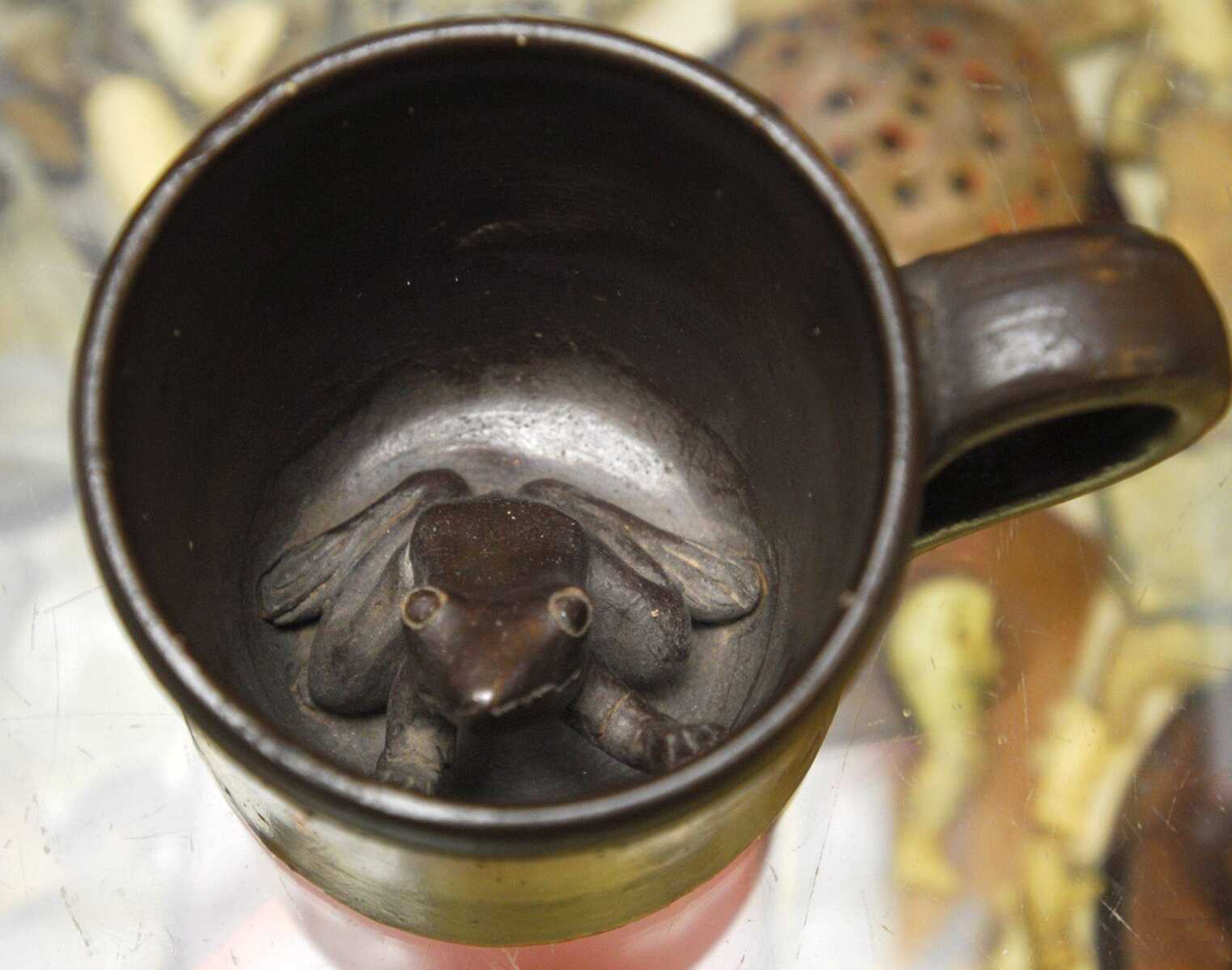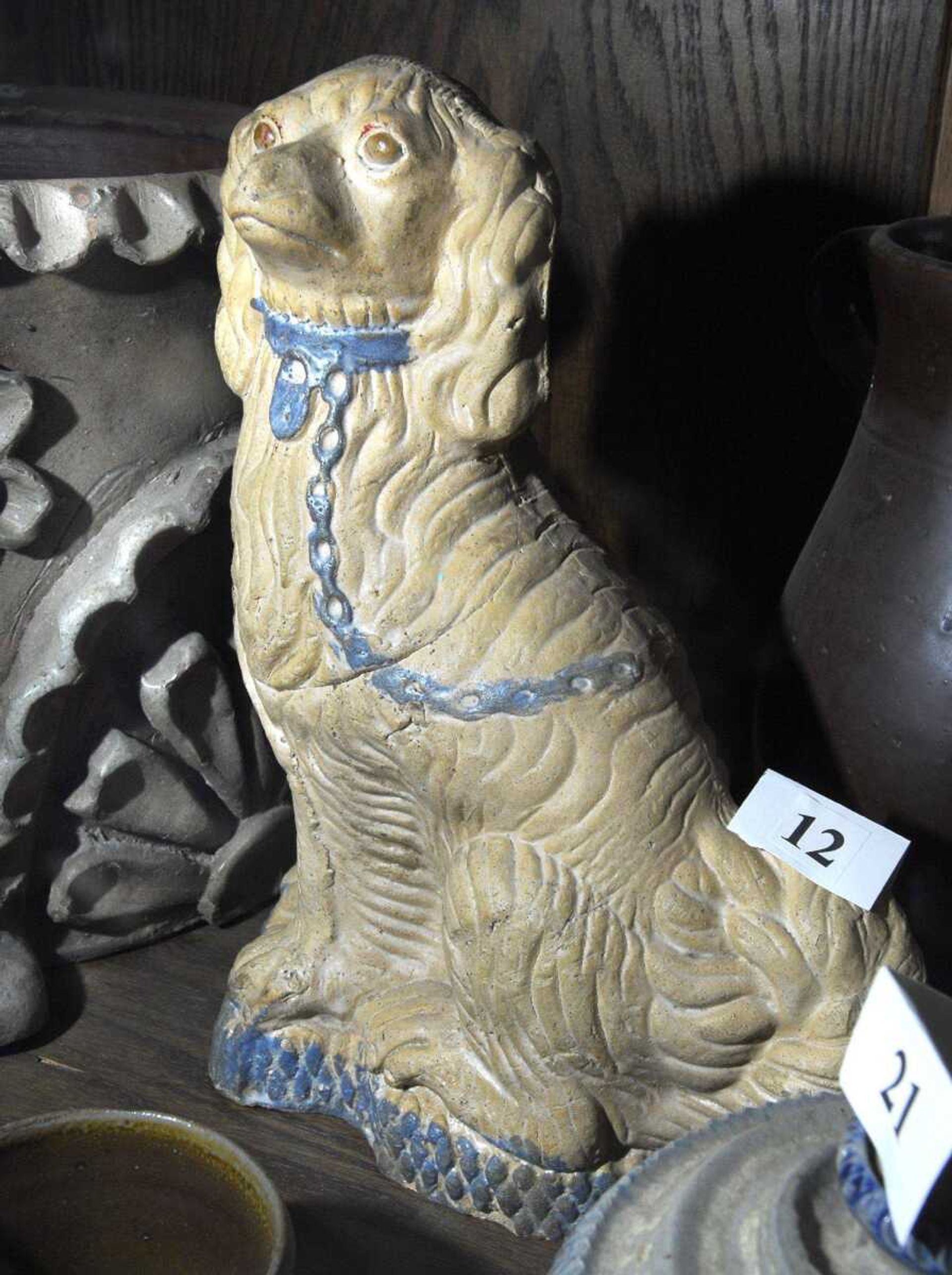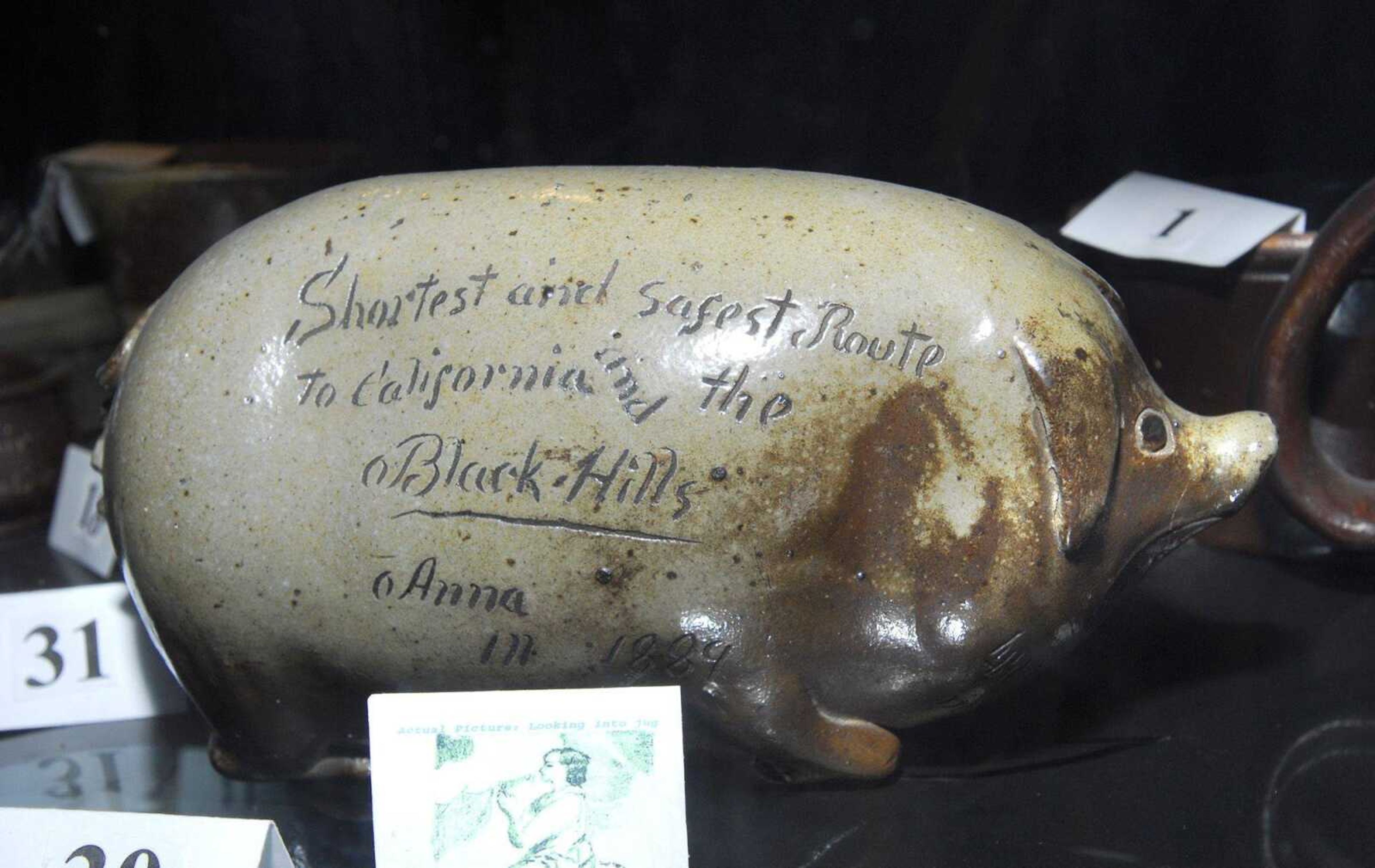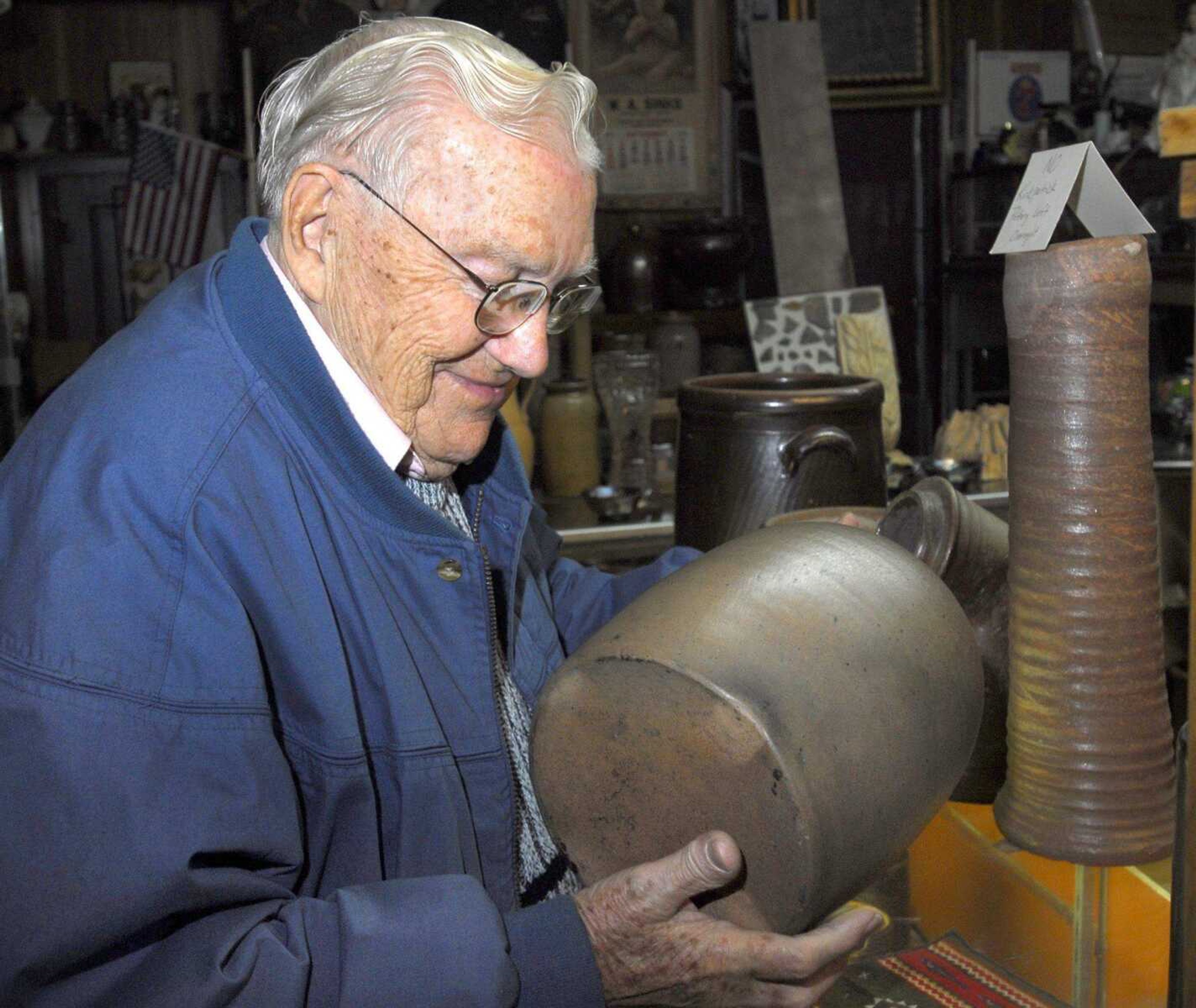ANNA, Ill. -- During the last half of the 19th century, brothers Cornwall and Wallace Kirkpatrick operated a pottery here that produced utilitarian and sometimes eccentric ceramic pieces. The 2,000 to 4,000 ceramic tobacco bowls they turned into pipes each day were among the bread-and-butter items that allowed the brothers the freedom to create jugs and flasks shaped like pigs, along with pots writhing with snakes and political messages.

The pottery also made stoneware crocks, drainage pipe, garden urns and novelty items. Their monument urns could be used instead of headstones. Their tiniest jugs might contain magnifiers, the better to see a kneeling angel and the Lord's prayer hidden inside. Inside other jugs, collector Pat Meller said, might reside "naughty ladies."
Today the Kirkpatricks' pieces are considered folk art, and some command many thousands of dollars from collectors.
The brothers' pottery became valuable in part because of the fine craftsmanship. Perhaps more important were observations on the politics of the day and ribald visual jokes incorporated into their pottery. Historians are as interested in their enigmatic work as art collectors.
One piece depicts snakeheads in the likenesses of political cartoonist Thomas Nast and his most famous target, "Boss" Tweed and his cronies. In his book "Pottery, Politics, Art: George Ohr and the Brothers Kirkpatrick," Richard D. Mohr writes, "At their best the pottery's designs are not only strikingly original -- I will argue seminal -- but surprisingly forwarded-looking, even contemporary, in their invocation of sexual, social, cultural and political themes." In Mohr's view, the Kirkpatricks influenced George Ohr, a contemporary who called himself "the mad potter of Biloxi." His work now is viewed as groundbreaking.
The brothers Kirkpatrick themselves willfully rejected Victorian prudery. An Anna Pottery flask with the plug at the pig's posterior was recently appraised on PBS' "Antiques Roadshow" for $5,000 to $7,000.
The Stinson Library in Anna and the Union County Museum in Cobden both have collections of Anna Pottery. One of the largest collections of Anna Pottery is housed at the pottery museum and antique store run by Mike Isom and his father, Tunney, at 111 N. Main St. in Anna. The store is just around the corner from where the pottery was situated on Vienna Street, a location now occupied by a restaurant.
Pat Meller donated her personal collection to the library and is a docent at the county museum, now closed for the winter until March 1. Among the standout pieces at the Union County Museum is a 4-foot-high nautically themed chimney pot once on the Riverlore Mansion in Cairo, Ill. A chimney pot was placed atop a chimney to prevent embers from settling on the roof.
The museum also has hearth tiles, a death mask and an umbrella stand that names the officers of the 1877 Jonesboro Fair. The acanthus leaves on some of the pottery were a trademark.
Some of the Kirkpatricks' work is in the Smithsonian Institution, including snake jugs that skewer corrupt tax revenuers. And yet, Meller said, "there are people around here who haven't heard of it."

Collectors began paying attention in the 1930s with the publication of stories about Anna Pottery in a national antiques magazine. New interest arose in the 1970s when graduate student Ellen Denker's thesis about the Kirkpatricks was published.
The Lakeview Museum of Arts and Sciences in Peoria, Ill., recently held an exhibit of Anna Pottery.
Collectors from all over the country come to the Isoms' store. Those hoping to claim a piece for themselves leave disappointed. Mike Isom said they occasionally sell a $20 crock jar if the store gets overcrowded, but their purpose is to serve as a resource for information about the Kirkpatricks' pottery. The museum and store are open from 10 a.m. to 5 p.m. seven days a week.
The store has hundreds of unmarked pipe bowls and many shards of the pottery. The finest works are in display cases removed from the premises every night because of their value.
Tunney Isom showed off a cup with a frog on the bottom meant to surprise the drinker. Other cups hold a scatological shock.

Andrew Kirkpatrick began operating a small pottery in Urbana, Ohio, in 1837. Seven sons, principal among them Cornwall and Wallace, followed him into the business. In 1858, Cornwall, Wallace and Andrew moved to Anna from Mound City. Beginning the following spring and continuing until the pottery closed in 1896, they and about 10 employees created utilitarian stoneware as well as novelties marketed all over the U.S. and abroad.
During the last quarter of the 19th century Illinois had almost 100 potteries. In Southern Illinois, the Kirkpatricks had a source of kaolin clay used to make their whitewares. They showed their work at international exhibitions and yet in their time went unnoticed as esteemed American potters.
Yet the Kirkpatricks were not ordinary potters. Cornwall stayed close to Vienna Street to manage the business and belonged to a temperance society. The man who became Anna's first mayor also was responsible for incising the pig flasks with railway maps and the like. Towns in disfavor could be found on the pig's backside, no matter where they actually were located.
Wallace represented the company at demonstrations and world exhibitions. He also collected snakes and presented snake shows to the public.
Snakes appear everywhere in Anna Pottery, including the lip of drinking jugs. "One school of thought is that the snake jugs were temperance messages," Mike Isom said. "Other people believe the jugs were so over the top that they were poking fun at temperance people and satirizing them."
Mohr's view is that on social issues the Kirkpatricks were "the liberals among liberals of their era."
Mike Isom began collecting the Kirkpatricks' pottery only seven years ago. Now it fills six display cases in the store and more is stored elsewhere. He calls it "great folk art first and foremost" but values the pieces as well for their insights into Cornwall's and Wallace's political opinions and the social norms of the day.
"They were casting their views in stone," he said.
sblackwell@semissourian.com
335-6611, extension 137
Connect with the Southeast Missourian Newsroom:
For corrections to this story or other insights for the editor, click here. To submit a letter to the editor, click here. To learn about the Southeast Missourian’s AI Policy, click here.








